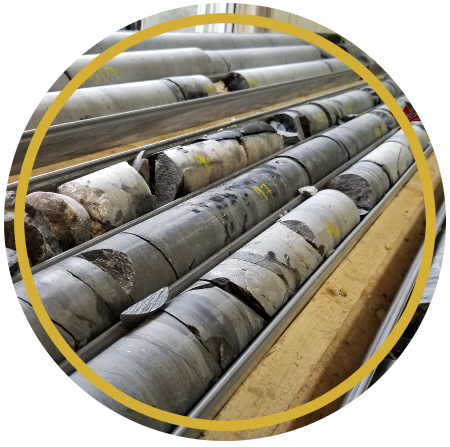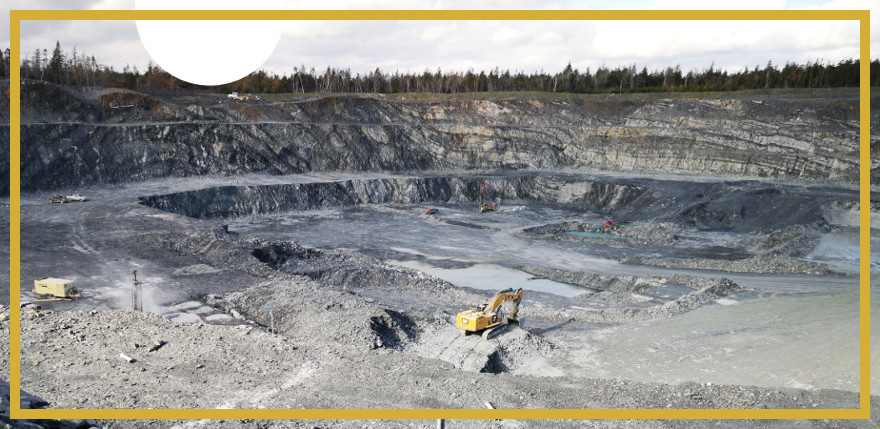- Why Mining Matters
- Jobs
- Safety
- Environment & Operations
- FAQ
- Links
- Fun Stuff

Misconceptions about modern gold mining stem from historical mining practices that we agree were not good enough. No industry took proper care of the environment 100-150 years ago. It was an era long before environmental awareness or scientific understanding of human impact on the environment. It was a time of people and companies dumping garbage and waste in rivers and forests. We agree that historical mines were not properly managed, just like most human activities back then. However, historical sites like these have nothing to do with modern mining.

Most industries have unfortunate legacy issues. Governments have paid to clean up sites like the Sydney tar ponds, Amherst Aerospace and Trenton's Tibbetts Paints. Mining also has legacy issues but they date from another era and the industry takes proper care of the environment today.
Modern mining is a sophisticated, science-based activity that takes proper care of the environment. Nova Scotia mines are stringently regulated by the provincial and federal governments.
Some people have questions about how we manage the environment, so below is information on some of the questions commonly raised.
Reclamation Bonds
Before getting operating permits, companies must get government approval of reclamation plans and post reclamation bonds (money in escrow, basically) that ensure funds are available to properly take care of sites.

Water Management
Mine operators are required by law to treat, strictly monitor and test water, and report back to the provincial Department of the Environment. Water is usually recycled on-site to reduce the overall amount that an operation draws from local sources. Water released back into a river or lake is usually cleaner after it has been used in a mine or quarry than it was beforehand.
Groundwater
Uranium and arsenic occur in all Nova Scotia rock. They are unstable and often leach naturally into groundwater. It's important to test wells for them. Mining does not release uranium and arsenic or create a problem that did not already exist. In fact, mines contain these materials in engineered facilities that protect water.
Mercury
Modern gold mines do not use mercury. It’s an obsolete method of processing that is harmful to the environment. Mercury has not been used in Nova Scotia since the early 1900s.
Watersheds
A watershed is an area where all water drains into a common water body. The term simply means a geographical area. All land is part of a watershed so virtually all human activities and infrastructure are in watersheds, including homes, roads, schools and industrial sites.
Fixing past Mistakes
Modern mines even sometimes fix issues with historical sites by cleaning up tailings or stabilizing land that was left unusable by the pick and shovel mining of the distant past. For example, the Moose River gold mine has cleaned up historical tailings in Moose River and the Point Aconi mine reclamation project fixed subsidence issues caused by historical bootleg coal mining.

Historical Tailings
Historical gold mine tailings are an unfortunate environmental legacy from 100-150 years ago. However, they have nothing to do with modern gold mining, which is a sophisticated, science-based activity that takes excellent care of the environment.
This is how early gold mining generally worked:
Many of Nova Scotia’s early gold miners were not miners by trade and they had no expertise in mining or metallurgy. They were often farmers, tradesmen and men drawn from any number of other professions because the only skill required was the ability to swing a hammer to smash rock.
Nova Scotia’s Lieutenant-Governor said during the province’s first gold rush in the early 1860s, "The thing most to be feared is that the hopes of large gain will induce many to neglect their ordinary avocations, which in a country like this, where the population is thin, cannot fail to act injuriously on the Colony, especially at this season of the year, when everyone engaged in agricultural pursuits ought to be occupied on his farm."
Some people made significant money but most gave up, having discovered that the work was harder and less profitable than they had imagined. Dreams of easy riches were dashed.
As the 1800s wore on, individual layman miners increasingly gave way to mining companies which, in some cases, had the resources and expertise to purchase and operate sophisticated mining and milling equipment. However, many companies still had little experience or expertise. Even the more sophisticated operators had no understanding of their impact on the environment, the 1800s and early 1900s being an era long before environmental science and regulations, or even environmental awareness.
Most Nova Scotia gold is in quartz veins so miners extracted the quartz with hammers and chisels, and sometimes with explosives as they became more sophisticated.
The gold-bearing quartz and other rock (ore) was then picked over for the best material – the pieces with visible gold. The ore was sent to a stamp mill, a large machine that crushed gold-bearing rock by stamping it over and over. Each stamp weighed about 800 to 1,000 pounds and repeatedly struck the ore, crushing it down to sand-sized particles.
In the 1800s, mercury was then used to separate the gold from the sand. Gold dissolves in mercury but mercury does not absorb other impurities, so it was effective at separating the gold from the pulverized ore. The mercury/gold mixture was recollected and heated until the mercury boiled away, leaving just the gold. A simple still like those used to make alcohol would draw away the vaporized mercury and collect it. The mercury was both valuable and reusable so early miners tried to capture all of it but, unfortunately, small amounts were often lost in the process.
The gold was then refined for greater purity and formed into bricks or nuggets.
The mining and milling process created waste rock, which just means rock leftover from extraction and processing. It was sometimes left in piles (dumps) at mine sites and sometimes used in construction at mines or in community roads, buildings and railways.
The process also generated tailings, which are what remained after the ore was crushed and treated to remove the gold. The tailings were dumped into nearby lakes, streams, or other natural depressions, a practice that is obviously unacceptable today but was standard 100-150 years ago.
Historical waste rock and tailings often contain significant quantities of gold. A lot of gold-bearing rock was discarded on waste piles because it did not contain visible gold or because the miners could not profitably extract from lower-grade ore. The milling process was inefficient, and often poorly managed, so it was common for 30% or more of the gold to be lost to the tailings, just like mercury often ended up in the tailings.
Attempts were made as early as the 1880s to extract gold from tailings but they failed due to the rudimentary science of the day. Unfortunately, this led to a belief that it was not worth trying to recover gold from tailings, something that can be done successfully today both for the gold and as part of remediating historical tailings.
Historical tailings often contain elevated concentrations of mercury, the result of mercury being lost in the milling process instead of being recollected as described above.
Historical mine sites also sometimes have high levels of arsenic. All rock contains arsenic so it can leach from waste rock piles into the environment. However, it must be understood that arsenic is unstable even when it is left underground, and it often leaches naturally into groundwater. This is why so many Nova Scotia wells have high levels of arsenic. Historical miners sometimes exacerbated the problem, but the problem also exists naturally.
No industry took proper care of the environment 100-150 years ago and mining was not an exception. However, modern mining is completely different. For example, Nova Scotia gold mines have not used mercury since the early 1900s and today, waste rock is contained in engineered facilities that ensure materials like arsenic cannot impact water.
Modern tailings, usually in the form of slurry, are stored in a tailings management facility – a lined and walled area on a mine site designed to contain the tailings indefinitely. The extensive science and engineering behind tailings management protects the environment. For example, site-specific geotechnical and engineering studies are done for each tailings facility to determine the best technical option to provide containment.
Mines today can often remediate historical tailings as part of the modern mining process, often by moving them into the modern mine’s tailings facility, as is being done at the Moose River gold mine.
Also, before getting operating permits, mining companies must get government approval of reclamation plans and post reclamation bonds (money in escrow, basically) that ensure funds are available to properly take care of sites. In fact, reclamation is a key part of the mining process today and progressive reclamation - reclaiming areas where extraction is complete while continuing to mine elsewhere on-site – is standard industry practice.


















































































